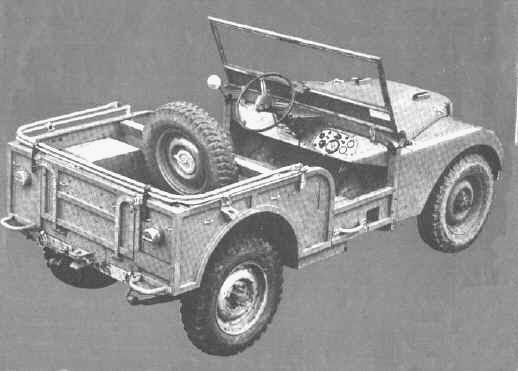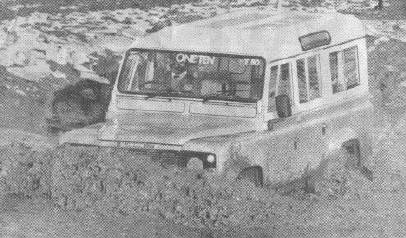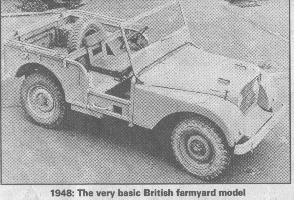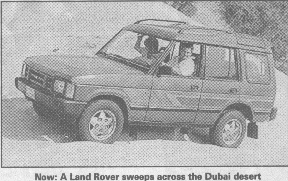Rover 825SD 800 Coupe 825i SD1 and Land Rover Web Site
![]()
The Land Rover Story
|
Immediately after
WWII, due to some rather odd attitudes of the UK government of the time (some
things never change), import duty and various other taxes had to be paid on
Jeeps or other vehicles that were left over from the war before they could be
registered and used on the roads. This made them prohibitively expensive for the
average motorist. This was a time of rationing; some say an even worse time than the war years. Since the government only made usable allocations of various vital materials, such as steel to industries that exported their goods, there were very few new cars for the public to buy on the domestic market. This contributed to another problem in later years, in that usually cars are developed from the feedback of a strong home market. The entire British motor industry tended to lag behind new trends right up to the 1970s and beyond partially because of this. In a sane world one would
have thought that the regulations on ex-military vehicles such as the jeep would
have been relaxed in the immediate post war years. After all a major part of the
recovery of the country at that time depended on transport. Nevertheless,
according to accounts from this time, many hundreds, perhaps thousands of brand new and
serviceable Jeeps were scrapped, buried in landfill or dumped at sea still in the packing cases.
All because of muddled thinking by the authorities. It is said there is a silver
lining to every cloud, in a way for the Rover Company this was true. Maurice and
Spencer Wilks, who were Rover's Chairman and Chief Engineer, had noticed that
ex-WWII Jeeps were much sought after by farmers. (If the vehicles were used off
road on farms etc then they did not need to be registered, and thus the
authorities were not “aware” of the existence of these machines.) The Wilks purchased an ex-US
army jeep. Driving it on their family farm quickly convinced them that a better
four-wheel drive machine could be made using the same basic engineering ideas.
It was realised that such a vehicle would also have a good export potential and
it could provide a stopgap solution to the desperate situation that Rover was
in, i.e. trying to get sufficient raw materials to manufacture it’s range of
cars. Hopefully it would provide some much needed revenue, and the government
would smile on them for their export efforts. During the early construction of the prototype, it was decided that using a steel chassis and combining it with a body made from aluminium panels would further eek out the allocation of steel. There were relatively huge amounts of sheet magnesium aluminium alloy left over from wartime aircraft production; this was not rationed, steel was. The alloy panels needed no complex new machinery to press them out, saving more investment. Using an engine, gearbox and other parts from the existing range of cars specially modified to suit the needs of a 4x4 vehicle made the Land Rover something of a kit car; but it also built in some proven reliability. It was said that the famous Land Rover bronze green paint only came about as there was a large quantity left over in a store from WWII! (Actually the early cars were painted with ex-RAF Ascot cockpit green). The Prototype Land Rover
When the design of the vehicle began there were many influences carried over from the Jeep on which the concept was based. Some of the body fittings and things like the single sided spring hanger are most noticeable to those familiar with the Jeep. It also borrowed at this stage axels, transfer box, and the steering box from the Jeep. This is why it and the first Land Rovers produced until 1954 also ended up with the Jeep's 80 inch wheelbase. The engine and main gearbox were from the old P2 car and this was mated to the Jeep Spicer transfer box. Early efforts were based on the same 'U' section type of chassis, but there was some flexing of the chassis and body under arduous off road conditions which was not a factor for the Jeep, (which was designed to be a disposable unit) but would not have been appropriate for the Land Rover. The massively strong box section type was decided on for production. Another of the early ideas was to mount the steering wheel in the centre of the vehicle to make it equally suitable for overseas markets as it made no difference if the traffic travelled on the left or right. In practice this idea was not convenient and all production vehicle were either left or right hand drive. Because there was no money for new tooling, the Company issued a directive to the design team. The Land Rover had to be made from as many existing parts as possible. Anything that could not be used from the range of Rover cars had to be hand made. This directive meant that the chassis, which would normally have been made from components pressed on huge machines that used expensive die tools, was assembled from steel plate cut and welded into box sections rails with the cross members fabricated in the same way. Initial chassis hit a problem. The welding process distorted the rail out of true as the first sides of the box section was welded. The solution was soon found, when the other pieces were welded in, the distortion pulled it true again! A rig or jig was developed for this by Olaffe Poppe called the "Christmas Tree" it had a lot of clamps to hold all the bits in place. The first production cars had the rear axel from the Rover P3 car which was modified to off set the differential to the right and the track altered slightly. The hub bearings and differential were the same as the car. The front axel casing a modified rear P3, to include swivel joints and special drive shafts for the drive to the front wheels. The engine and gearbox were straight out of the P3 4 cylinder "60" car. The newly designed transfer box was fitted to the rear of the 4 speed box and the gear lever linkage had to be altered. This left a hole which was covered by a plate, a feature that was still visible on series 3 gearboxes over 20 years later. Mounted on the chassis was a steel bulkhead, built by hand along with aluminium body panels. Galvanized steel capping was used on panel tops and corners. Looking at the body it has more than a passing resemblance to the way aircraft were put together, with rivets spot welds body strengtheners etc. The "shadow" factory had produced aircraft parts during the war and there must have been many skilled sheet metal workers available. Because a Series I is flat out at around 50mph few people would have one as their sole means of transport. Long journeys are, well very long journeys, and unless you have all day can be very tedious. Not only that, the mechanical noise you will hear will set the ears ringing. I have been told recently that
the reason the original Series 1's top speed of 50mph was not to do with
the engines ability, but related to the fact that when they were introduced to
the UK Market, they were classified as commercial vehicles, this was to avoid
paying the higher rate of tax that was imposed for all none commercial vehicles.
The downside to classifying them as commercial was that under the law of the
time, the maximum speed of the vehicle could be no greater than 50mph.... About 218,000 Series Is were
built between 1948 and 1958.
* IOE means:- overhead inlet, side exhaust valves.
The Series 11 was
announced on the l0th anniversary of Land Rover in 1958. Rather than being
a totally new vehicle it was an evolution of the final Series Is. The Rover styling
department had had come up with a barrel-sided styling to cover the
wider-track axles, sill panels covered the chassis frame where it had been
visible on the Series I, there was also a newly designed truck cab, and a
generally tidier overall appearance. The 109-inch Station Wagon arrived a
little after the other models, and now looked like an integrated design
instead of the Meccano set of the old 107 Station Wagon. A big step forward
for the Series II was the overhead-valve petrol engine. It was very
similar to the 2-litre diesel but was 2.25 litres. This improved the road
performance and brought with it extra torque for off road use. In 1961 the Series
IIA model replaced the Series II. There were some slight differences,
appearance wise the most noticeable was the loss of the chromed headlight
trims. The main change was that the diesel version had a 2.25-litre option
instead of the original 2-litre type.
Numbers About 110,000 Series Ils and 340,000 Series IIA were produced. 1958-1971.
The Series III came
in 88 and 109-inch wheelbases. The One Ton, 1.3 tonne with Hi Cap was
introduced on the Series III. Otherwise as far as bodywork was concerned
it was very much the same as the Series IIA. The main visual difference
was flatter bonnet and door hinges and a change to a plastic front grill,
instead of the galvanized wire mesh type.
The four-cylinder
engines even in the 88 lacked road performance, and in 109 models were
simply not able to keep up with modern traffic, especially when fully
loaded or towing. Nor were these engines particularly fuel-efficient,
another consideration in increasingly environmentally aware times. Towards
the end of Series III production, there was a boom in the sales of sale of
imported passenger-carrying 4x4 in Britain. Many 109 buyers were switching
to Japanese 4x4 pick-ups with their more powerful engines and car like
interiors. Land Rover somewhat belatedly tackled this problem by introducing the V8 3.5 litre engine, which in 1979 replaced the 2.6 6-cylinder option on the 109. The vehicles so treated were generally known as the Stage 1 V8 and was thought to be available on the long wheelbase chassis only, however there were a few special order versions on the 88 chassis. Station Wagon models were sold in much larger numbers towards the end of this period, still unmistakably with its roots as a utility vehicle but with more concessions to passenger comfort. Engines
Numbers There were more Series III built than any other type when the production run finished. About 440,000. 1971-1985. These vehicles were the most radical change that Land Rover had ever made to its range of models. They were distinguished visually by a one-piece windscreen, a radiator grill that was flush with the front of the wing panels and wheel arch extensions to cover the wider-track axles which were very similar to those used on the Range Rover. Otherwise, they looked much the same as Land Rovers had done since 1958. Bodies were the same selection of soft top, hardtop, HCPU and Station Wagon seen on the Series III. County Station Wagons had "de luxe" fittings. Some extra room in the cab section for the driver and front seat passengers was welcome too.
Engines 90 / 110
C 2001. From notes collected in the 1960s by my father, and my own addition of later information. Something that had started as a temporary means of helping to ensure Rover's future became one of the most famous makes in the world.
|
|||||||||||||||||||||||||||||||||||||||||||||||||||||||||||||||||||||||||||||||||||||||||||||||||||||||||||||||||||||||||||||||||||



